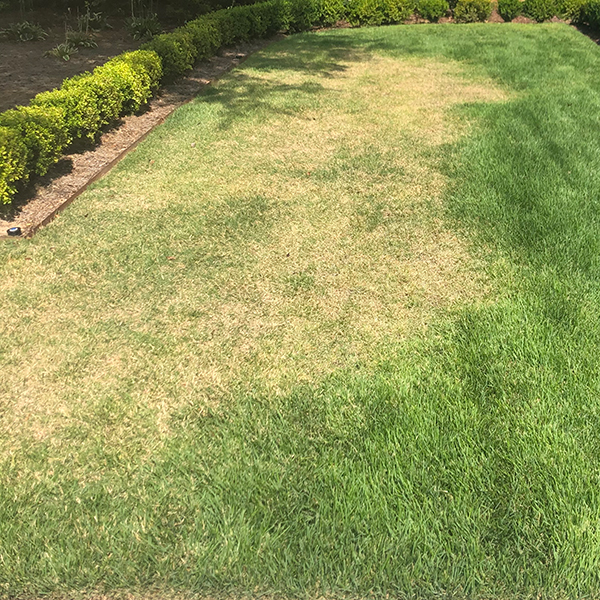Fall Armyworm Control in Arkansas

They may be called fall armyworms but they usually show up during July in central and southern Arkansas. We are seeing fall armyworm damage right now, late July, here in Little Rock. As with most pests, it’s helpful to understand the life cycle, preferred plant hosts and symptoms in order to better control the pest.
Fall armyworms are a different species than true armyworms; both are the adult larval stage of moths. In central and southern Arkansas, fall armyworms are more common because they prefer warm season grasses, which are more prevalent here. True armyworms prefer cool season grasses and are more of an issue in northern Arkansas, where cool season grasses are more prevalent. The two are also present at different times of the year. True armyworms are a spring issue, and fall armyworms become evident around mid-summer.
Fall Armyworm Life Cycle
Fall armyworms can’t survive our winters; the adult white moth overwinters in southern Texas, southern Florida, Central America or South America. They are carried hundreds of miles northward by wind. Adult moths lay eggs, typically on a vertical structure such as a fence or upright plant. Once the eggs hatch, the larva move downward to the ground. They start eating… and if they are eating a preferred host, they quickly grow into large adult larva that can quickly damage a lawn or agricultural crop, such as maize or hayfields.
The small larva don’t do as much damage at first, but as they grow and go through multiple instars (growth stages), they eat more and more. By the time damage is visible, the armyworms are in the adult larval stage or close to it. Signs to look for are as shown in the image above; a pretty defined wave of damage. Bermuda grass, especially newly installed sod, are the prize host of cultivated landscapes but they will also damage a zoysia grass lawn.
Symptoms to Look For
Starting in mid July, be on the lookout for symptoms such as defined thinning lawn areas. Other pest such as grubs and lawn fungus can also cause yellowing or grass decline but are usually in more irregular shapes and spotted through a landscape versus a wave-like area. Frequent mowing disturbs fall armyworms, reducing the population and damage. Rain is a fall armyworm’s best friend; the larva can really do a lot of damage when lawns are too wet to cut and get a bit tall. The height of the grass blades can disguise them as they eat and grow.
Fall Armyworm Treatment
Fortunately, this is a pest that is easy to identify; adult fall armyworms are caterpillars with dark stripes and a light colored inverted Y on their heads. Ferti-Lome Natural Guard makes a great product containing spinosad which works both on contact and is toxic when ingested by chewing insects (product name is Spinosad or Spinosad Soap). Hi-Yield 38 Plus, containing permethrin, is also effective. Ferti-Lome Natural Guard Caterpillar Killer Spray with Bt containing bacillus thuringiensis, disrupts the digestive system of small fall armyworms. It’s a good selective control option; it controls the pest without harming a lot of other insects. Bonide Systemic Insect Control containing acephate is another option. There are other chemical options available as well; just look for armyworms or caterpillars as a listed pest it controls on the label.
Typically, a healthy bermuda or zoysia lawn has time to recover from fall armyworm damage before fall. However, because severe fall armyworm damage weakens the lawn, treatment is recommended to lessen the affects.
If you read our recent post about bagworms, you might have noticed that the treatment options are the same. Both are caterpillars; chewing insects that are ingesting plant leaves. Insects like lacebugs do damage by piercing the plant leaves in order to suck up plant juices. Treatment for these insects is different because of how they are ingesting the plant. This is one reason proper pest identification is the first step in an effective treatment plan.
We invite you to stop by The Good Earth with pictures or samples of your pest or plant issues so we can work with you to successfully address the issue!